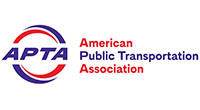Standard
Transit Communications Interface Profiles
Abstract
TCIP is an interface standard. Its primary purpose is to define standardized mechanisms for the exchange of information in the form of data among transit business systems, subsystems, components and devices. The standardization of these interfaces is intended to reduce the cost of future procurements of transit computer based systems, and to facilitate a greater degree of automation and integration of those systems.
| Document Number | Version | Publication Date | Publication | Related Information |
|---|---|---|---|---|
| APTA TCIP-S-001 | 4.1.1 Vol. 1 | 05/04/2015 | Published | Narrative |
| APTA TCIP-S-001 | 4.1.1 Vol. 2 | 05/04/2015 | Published | Data and Dialog Definitions |
| APTA TCIP-S-001 | 4.1.1 Vol. 3 | 05/04/2015 | Published | XML Schema |
| APTA TCIP-S-001 | 4.1.1 Vol. 4 | 05/04/2015 | Published | Annexes F-K |
Keywords
Summary
The TCIP Standard is organized into 4 volumes. This section describes the contents of each volume.
Volume I of the TCIP Standard contains the Narrative. The narrative is divided into 10 sections as shown below:
- Section 1 – Overview – General Description and background of TCIP
- Section 2 – References and Definitions – Ties TCIP to other standards and defines terms and acronyms used in the standard.
- Section 3 – TCIP Data –Describes how TCIP defines data in ASN.1 and XML.
- Section 4 – Understanding TCIP – Provides background information and defines the Model Architecture.
- Section 5 – Concept of Operations – Provides a high-level discussion of transit agency operations, and business processes. This section ties these operations and processes to the TCIP dialogs and file transfers that support them.
- Section 6 – TCIP Message Encoding – Defines TCIP supported encoding of data for transmission.
- Section 7 – Dialog Patterns – This section defines the dialog patterns that are used to specify TCIP Dialogs. Dialog Patterns specify the rules for exchanging messages, message definitions define the content of messages, and dialog definitions specify a set of messages to be used according to the rules in the dialog pattern to accomplish a data transfer.
- Section 8 – Conformance – Defines Conformance requirements for TCIP conformant implementations.
- Section 9 – TCIP Procurements – Describes how an agency can go about procuring TCIP conformant systems. This section is informative and does not levy conformance requirements.
- Section 10 – TCIP Communications – Discusses communications networks used by TCIP Implementations. This section is informative and does not levy conformance requirements.
Volume II of the TCIP Standard contains the data and dialog definitions for TCIP. This volume is organized into
four annexes as shown below:
- Annex A – Data Element Definitions in ASN.1
- Annex B – Data Frame Definitions in ASN.1
- Annex C – TCIP Message Definitions in ASN.1
- Annex D – TCIP Dialog Definitions
- Annex F – This material intentionally deleted
- Annex G – National ITS Architecture Traceability Mapping
- Annex H – Base Type Definitions Annex I – TCIP Narrow Band Encoding. This annex defines an example mechanism for encoding information for transfer across limited capacity communications links.
- Annex J – TCIP Polling Protocol. This annex defines an example polling protocol for use over private narrowband radio systems.
- Annex K – Sample PRL and PICS
Get Involved
Want to participate in development of this document? Join the Working Group or Learn More
Related Documents
|




